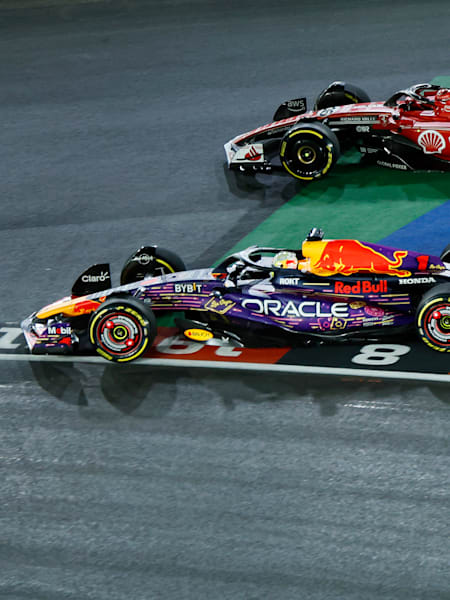Red Bull Motorsports
Formula 1 (F1) qualifying is a high-stakes process that sets the stage for a spectacular race day. It’s also an important part of determining the starting positions at a Grand Prix weekend. Mere hundredths of a second can make all the difference.
F1 qualifying isn’t just about speed, though. Drivers also need to factor in strategy, precision and nerves of steel. That electrifying atmosphere is quite apparent at F1 events like the Red Bull Energy Station at the Las Vegas Grand Prix. But how precisely does F1 qualifying work?
01
The F1 qualifying format
F1 qualifying follows a knockout format divided into three intense sessions: Q1, Q2, and Q3. This system ensures that only the fastest drivers make it to the top, while the slower ones are gradually eliminated.
The primary objective is to set the fastest lap time within the allotted minutes of each session. The knockout format ensures a thrilling progression of intensity, with each session eliminating the slower competitors until only the best remain.
Each qualifying session has a specific duration and purpose. Q1 lasts 18 minutes and includes all 20 drivers who are competing to qualify. The goal is to set a fast enough lap time to avoid being among the five slowest drivers, who are then eliminated. Q2 is a 15-minute session with the remaining 15 drivers, where the slowest five are once again eliminated. The final session, Q3, is a 12-minute sprint involving the top 10 drivers. They battle for the pole position at the front of the line and other leading spots on the starting grid.
02
Qualifying sessions breakdown
Q1: The first round of elimination
The elimination process in Q1 adds immediate pressure, as every driver must push to deliver a competitive time right from the start. As all 20 drivers take the track for 18 minutes of high speed competition, the objective is simple: just don’t get eliminated. By the end of Q1, the five slowest drivers don’t move on. The remaining 15 drivers progress to Q2.
Q2: Deciding the top 10
The competition heats up even more as the remaining 15 drivers once again strive to avoid being in the bottom five. Drivers are allowed to use the same tires as the ones that landed them in the top 15 in Q1. Strategy becomes key in Q2 as drivers not only work to set a fast lap but also have to manage tire wear and consider the race ahead. By the end of Q2’s 15 minutes, the top 10 are determined and ready to move on to the final session.
Q3: Battle for pole position
Q3 is the climax of the qualifying process, a 12-minute showdown among the 10 fastest drivers. Every millisecond counts as drivers vie for the top positions on the starting grid. The fastest lap time in Q3 secures the pole position, a prime spot that offers a significant advantage for the race. The rest of the top 10 positions are also determined in this session. Q3 sets the stage for the Grand Prix with the fastest drivers at the front.
03
Key rules and regulations
F1 qualifying is governed by a set of rules designed to ensure fair competition and safety.
1. Tire rules and allocation
- During qualifying, teams must manage their tire allocation carefully. They only have 20 tire sets to use throughout the race weekend, and their tire choices in qualifying can significantly impact their race strategy. Using the wrong tire compounds in Q1 or Q2 could knock a driver out of the rankings for Q3.
Sergio Perez makes a pitstop during the F1 Grand Prix of Spain in 2023
© Getty Images / Red Bull Content Pool
2. Impact of penalties
- Penalties can significantly affect qualifying positions. Some violations simply result in reprimands, but more severe penalties, such as time or grid penalties, can alter the starting positions determined in qualifying. For instance, a driver who originally qualified for pole position but receives a five-place grid penalty has to start from P6, or the sixth position in the starting grid.
- Infractions occur for a number of reasons. Drivers might exceed the permitted number of engine component changes, enter the pit-lane faster than the designated speed, or breach Safety Car regulations.
3. Minimum lap time requirement (107% rule)
- The 107% rule is meant to confirm that all drivers are fast enough to battle it out in Q3. The rule states that a driver must set a lap time within 107% of the fastest time in Q1 to qualify for the final race. If the fastest Q1 lap is 100 seconds, the slowest driver needs to lap within 107 seconds. Otherwise, they risk being disqualified to race on Sunday of the Grand Prix weekend. Part of the logic behind this rule is preventing dangerous situations if cars run at extremely different speeds, specifically when faster cars lap slower drivers.
04
Strategies in qualifying
Qualifying is not just about raw speed. It's also about strategic thinking and precise execution.
Tire strategy
Red Bull Racing team prepare for a pitstop at the F1 Grand Prix of Brazil
© Getty Images / Red Bull Content Pool
Tire strategy plays a vital role in qualifying. Teams must decide which tires to use in each session, balancing the need for speed with the need to preserve tires for the race. Since different tire compounds react differently to certain track settings, tire choice can be the difference between advancing to the next session or being eliminated.
Timing and track position
Timing is everything in F1 qualifying. Drivers aim to hit the track when traffic is clear, maximizing their chances of setting a fast lap with no other cars blocking the way. Teams monitor track conditions and competitor activities to send their drivers out at the optimal time.
High-stakes battle for pole position
The qualifying sessions — Q1, Q2, and Q3 — determine the starting grid, with the ultimate goal of securing pole position. Understanding how F1 qualifying works provides a deeper appreciation for the skill and strategy involved in this high-octane sport. As the drama unfolds, remember that every second counts, and every decision matters.










